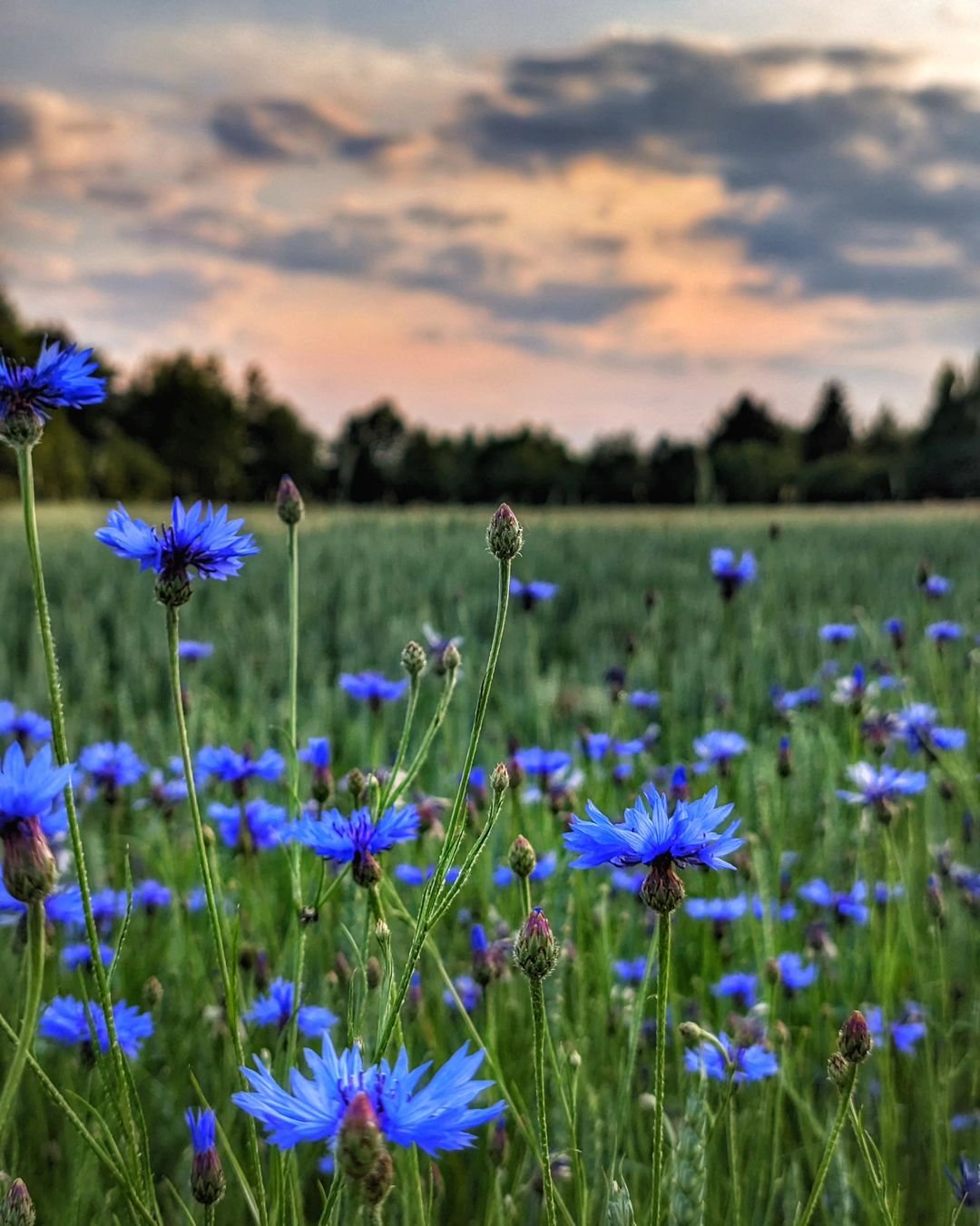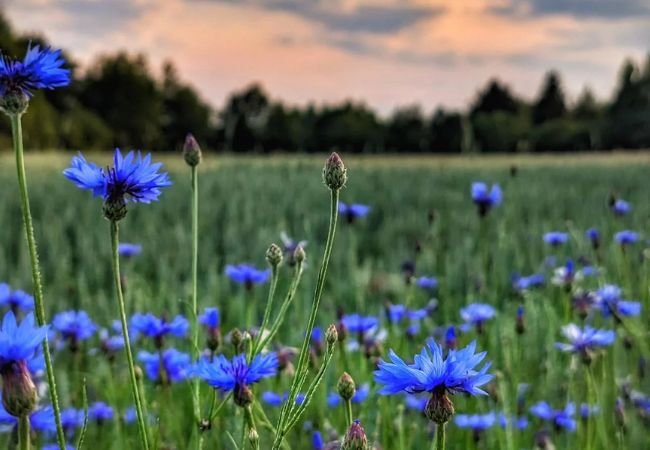Discover the joy of cultivating vibrant cornflowers also known as bachelor’s buttons. This comprehensive guide covers everything from choosing the right varieties and planting techniques to caring for these stunning bloomers. Learn how to add a pop of color to your garden while enjoying the numerous benefits of growing cornflowers.
In the kaleidoscope of garden wonders, few flowers can match the charm and allure of cornflowers also known as bachelor’s buttons. These delightful bloomers with their distinctive frilled petals and vibrant hues, have captured the hearts of gardeners worldwide adding a pop of color and whimsy to any outdoor space. Whether you’re a seasoned green thumb or a budding enthusiast, cultivating cornflowers can be a rewarding and enjoyable journey. In this comprehensive guide, we’ll delve into the captivating world of these stunning flowers, exploring the essential steps to ensure a bountiful and eye-catching display.
Here’s a short chart with information about Cornflowers (Centaurea cyanus):
| Aspect | Information |
|---|---|
| Botanical Name | Centaurea cyanus |
| Common Names | Cornflower, Bachelor’s Button |
| Plant Type | Annual |
| Zones | 2-11 (annual); hardy in all zones as an annual |
| Exposure | Full sun |
| Bloom Time | Late spring to early summer |
| Height/Spread | 1-3 feet tall, 1-2 feet wide |
Unraveling the Beauty of Cornflowers

A Botanical Gem
Before we embark on the cultivation process, let’s take a moment to appreciate the unique characteristics of cornflowers. Scientifically known as Centaurea cyanus, these annual flowering plants belong to the Asteraceae family and are native to Europe and parts of Asia. Despite their name, cornflowers are not actually related to corn but were commonly found growing among cereal crops, earning them their moniker.
A Kaleidoscope of Colors
One of the most alluring aspects of cornflowers is the stunning array of colors they offer. From classic shades of blue and purple to vibrant pinks, whites and even bicolors, these flowers have the power to transform any garden into a vibrant canvas of hues. Some popular varieties to consider include:
Classic Centaurea
This variety boasts deep blue petals surrounding a striking purple center, capturing the quintessential beauty of cornflowers.
Polka Double
A unique variety with frilled, double-petaled blooms in shades of blue, pink and white, adding texture and depth to your garden display.
Black Ball
As the name suggests, this variety features deep, almost black-purple blossoms that create a dramatic contrast against the greenery.
Midnight Cloud
A stunning blend of maroon and purple hues, creating a striking and captivating contrast that is sure to turn heads.
Planting and Growing Conditions
Cornflowers are relatively easy to grow and thrive in well-draining soil and full sun exposure. They can be sown directly into the garden or started indoors for earlier blooms. To ensure success, follow these tips:
Soil Preparation
Cornflowers prefer well-draining, slightly alkaline soil. Amend your soil with compost or other organic matter to improve drainage and nutrient content, creating an ideal environment for these beauties to flourish.
Sowing and Transplanting
If sowing directly outdoors, plant the seeds about 1/4 inch deep and 6-8 inches apart after the last frost. For indoor starts, sow seeds in seed trays or containers 6-8 weeks before the last expected frost date. Once the seedlings have developed their first set of true leaves, transplant them into your garden, spacing them 12-18 inches apart.
Sunlight Requirements
Cornflowers thrive in full sun exposure, requiring at least 6 hours of direct sunlight per day for optimal growth and blooming. Choose a location that receives ample sunlight to ensure your plants reach their full potential.
Caring for Your Plants
While cornflowers are relatively low-maintenance, providing proper care will ensure a vibrant and long-lasting display. Here are some essential tips to keep your blooms thriving:
Watering Practices
Keep the soil consistently moist but not waterlogged, especially during the initial establishment phase. Once established, cornflowers are relatively drought-tolerant but occasional deep watering will help promote healthy growth and prolific blooming.
Deadheading and Staking
Regularly remove spent blooms to encourage more flower production and prevent self-seeding. Taller varieties may benefit from staking or caging for support, especially in windy conditions, to ensure they maintain their upright and graceful form.
Mulching and Pest Control
Apply a 2-3 inch layer of organic mulch around the plants to retain moisture and suppress weeds. Monitor your plants for pests and address any infestations promptly using organic or natural methods to maintain the health and vitality of your cornflower patch.
Harvesting and Displaying
Cornflowers make excellent cut flowers and can also be enjoyed in the garden. Here are some tips for harvesting and displaying these beauties:
Cutting and Arranging
Cut the stems in the morning when the flowers are fully open and the dew has dried. Leave at least 6 inches of stem for vase life. Arrange them in beautiful bouquets or incorporate them into stunning floral displays to bring a touch of vibrancy to your indoor spaces.
Drying and Crafting
Cornflowers are perfect for drying and can be used in dried flower arrangements or potpourri. Explore creative ways to incorporate these dried blooms into various crafts, such as wreaths or decorative accents, allowing you to enjoy their beauty year-round.
Edible Delights
The petals of cornflowers are edible and can be used to add a pop of color and subtle flavor to salads, baked goods, and even beverages. Experiment with incorporating these edible blooms into your culinary creations for a touch of whimsy and natural beauty.
Cornflowers are truly a gardener’s delight, offering a captivating array of colors, textures and versatility. By embracing the cultivation techniques outlined in this guide, you’ll be well-equipped to create a vibrant and eye-catching display of these stunning blooms. Immerse yourself in the captivating world of cornflowers and let their beauty and charm elevate your outdoor space to new heights of splendor.








Leave a Reply